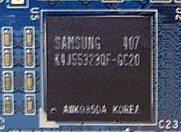 The
main advantage DDR2 has over good ole DDR memory is that it runs on a lower
voltage, which lowers the power requirements, and allows it to scale higher with a small
latency penalty.
The
main advantage DDR2 has over good ole DDR memory is that it runs on a lower
voltage, which lowers the power requirements, and allows it to scale higher with a small
latency penalty.
GDDR3
(Graphics Double Data Rate3) takes this one step further, requiring less
voltage than DDR2, and scaling even futher (though with some
latency penalty). While the motherboard industry is making the transition from
DDR to DDR2 memory, right now GDDR3 is only used on graphics cards. There are no
current plans to migrate GDDR3 to the motherboard level - but who knows what the
situation will be a year or two
down the road. GDDR3 and DDR2 do share one thing in common, they are
only packaged in BGA modules - leaving the old TSOP-II to be finally
retired.
Micron were first out of the gate with GDDR3 DRAM modules, but the memory found on
the Albatron GeForceFX 5700 Ultra is actually using Samsung K4J55323QF-GC20 GDDR3 DRAM. Compared to the Samsung K4N26323AE-GC22 DDR2 DRAM modules we find
on earlier cards, the Samsung GDDR3 memory requires just 2.0V compared
to 2.5V for DDR2. This which should help ease up on power consumption.
However, as GDDR3 RAM
runs with an even higher latency than DDR2, nVIDIA have had to clock the memory 50
MHz higher as well. This should offset any performance penalty that GDDR3 has
over DDR2.
Overclocking the FX5700U3!
 As usual we started with the core overclocking first; from
450 MHz we slowly went up a few MHz at a time. The core was a pretty good
overclocker and the FX5700U3 went all the way up to 571 MHz before it started to have
any problems. Anything higher though, and the computer would lock up when running any 3D
application.
As usual we started with the core overclocking first; from
450 MHz we slowly went up a few MHz at a time. The core was a pretty good
overclocker and the FX5700U3 went all the way up to 571 MHz before it started to have
any problems. Anything higher though, and the computer would lock up when running any 3D
application.
Since
this is the
first time we've dealt with GDDR3 we really don't know what to expect from the
memory... but with 2ns DRAM we were hoping to hit some nice speeds. By default the
memory is clocked at 950 MHz, 50 MHz higher than regular GeForceFX 5700 Ultra
DDR2 based videocards. This is done to make up for a small latency
penalty.
Not
surprisingly we were able to crack the 1 GHz mark quite easily, but we were not
able to go much higher than that. The maximum speed the FX5700U3 memory reached
1.02 GHz - if we tried to go higher we'd be greeted by artifacts like in
the Raiders of the Lost Arc... you remember the big artifacts that spit out poison tipped
darts, gigantic rock bowling balls, and all that fun stuff? Same thing here. :-)
 |
| PCStats Test System Specs: |
| processor: |
intel pentium 4 3.0c |
| clock
speed: |
15 x 200 mhz = 3.0
ghz |
| motherboards: |
gigabyte 8knxp, i875p |
| videocard: |
ati radeon 9800xt
ati radeon 9800 pro
ati
radeon 9700 pro
asus radeon 9600xt
msi fx5950 ultra-td128
msi fx5900u-vtd256
msi
fx5900xt-vtd128
gigabyte gv-nv57u128d
albatron geforcefx 5700 u3 |
| memory: |
2x 256mb corsair twinx
3200ll |
| hard drive: |
40gb wd special
ed |
| cdrom: |
nec 52x cd-rom |
| powersupply: |
vantec stealth 470w |
| software setup |
windowsxp build 2600
intel inf 5.02.1012
catalyst 3.9
detonator
53.03 |
| workstation benchmarks |
3dmark2001se
codecreatures
aquamark
aquamark3
gun metal 2
x2 the
threat
ut2003
aa test, af and
aa+af test
3dmark2001se
x2 the threat
ut2003 | |
By
combining DirectX8 support with completely new graphics, it continues to provide
good overall system benchmarks. 3DMark2001SE has been created in cooperation
with the major 3D accelerator and processor manufacturers to provide a reliable
set of diagnostic tools. The suite demonstrates 3D gaming performance by using
real-world gaming technology to test a
system's true performance abilities. Tests include: DirectX8 Vertex Shaders,
Pixel Shaders and Point Sprites, DOT3 and Environment Mapped Bump Mapping,
support for Full Scene Anti-aliasing and Texture Compression and two game tests
using Ipion real-time physics.
Higher
numbers denote better performance.
It
shouldn't be any surprise that the Albatron GeForceFX 5700U3 performs the same as
the Gigabyte GeForceFX 5700 Ultra. Overclocking boosts the score a bit.
